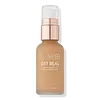Flower Beauty by Drew Light Illusion Liquid Foundation Versus Flower Beauty by Drew Get Real Serum Foundation
What's inside
What's inside
 Key Ingredients
Key Ingredients

No key ingredients
 Benefits
Benefits

 Concerns
Concerns

 Ingredients Side-by-side
Ingredients Side-by-side

Water
Skin ConditioningEthylhexyl Palmitate
EmollientButylene Glycol
HumectantCaprylic/Capric Triglyceride
MaskingButylene Glycol Dicaprylate/Dicaprate
EmollientGlycerin
HumectantEthylhexyl Methoxycinnamate 5%
UV AbsorberTitanium Dioxide 2%
Cosmetic ColorantZinc Oxide 4.9%
Cosmetic ColorantNeopentyl Glycol Diethylhexanoate
EmollientCetyl Ethylhexanoate
EmollientPEG-30 Dipolyhydroxystearate
EmulsifyingPentylene Glycol
Skin ConditioningCetyl PEG/PPG-10/1 Dimethicone
EmulsifyingPolymethyl Methacrylate
PEG-10 Dimethicone
Skin ConditioningCyclopentasiloxane
EmollientPhenoxyethanol
PreservativeMagnesium Sulfate
Sorbitan Isostearate
EmulsifyingBeeswax
Emulsion StabilisingStearalkonium Hectorite
Gel FormingTriethoxycaprylylsilane
Aluminum Hydroxide
EmollientStearic Acid
CleansingDimethicone
EmollientEthylhexylglycerin
Skin ConditioningDisodium EDTA
Iron Oxides
Mica
Cosmetic ColorantWater, Ethylhexyl Palmitate, Butylene Glycol, Caprylic/Capric Triglyceride, Butylene Glycol Dicaprylate/Dicaprate, Glycerin, Ethylhexyl Methoxycinnamate 5%, Titanium Dioxide 2%, Zinc Oxide 4.9%, Neopentyl Glycol Diethylhexanoate, Cetyl Ethylhexanoate, PEG-30 Dipolyhydroxystearate, Pentylene Glycol, Cetyl PEG/PPG-10/1 Dimethicone, Polymethyl Methacrylate, PEG-10 Dimethicone, Cyclopentasiloxane, Phenoxyethanol, Magnesium Sulfate, Sorbitan Isostearate, Beeswax, Stearalkonium Hectorite, Triethoxycaprylylsilane, Aluminum Hydroxide, Stearic Acid, Dimethicone, Ethylhexylglycerin, Disodium EDTA, Iron Oxides, Mica
Water
Skin ConditioningPropanediol
SolventNeopentyl Glycol Dicaprate
EmollientCaprylic/Capric Triglyceride
MaskingTriethylhexanoin
MaskingC9-12 Alkane
SolventGlycerin
HumectantPolymethylsilsesquioxane
Glyceryl Oleate
EmollientC13-15 Alkane
SolventPolyglyceryl-3 Polyricinoleate
EmulsifyingLactobacillus Ferment
Skin ConditioningSilica
AbrasiveSodium Chloride
MaskingSorbitan Isostearate
EmulsifyingLavandula Angustifolia Flower Water
Skin ConditioningQuaternium-90 Bentonite
Magnesium Aluminum Silicate
AbsorbentGlyceryl Caprylate
EmollientCoco-Caprylate/Caprate
EmollientTriethyl Citrate
MaskingLauroyl Lysine
Skin ConditioningOlea Europaea Oil Unsaponifiables
Skin ConditioningAcacia Senegal Gum
MaskingXanthan Gum
EmulsifyingBetaine
HumectantDisodium EDTA
Capric Acid
CleansingPotassium Sorbate
PreservativeTremella Fuciformis Sporocarp Extract
AntioxidantWithania Somnifera Root Extract
Skin ConditioningLavandula Hybrida Oil
EmollientTocopherol
AntioxidantCitric Acid
BufferingSodium Benzoate
MaskingPhenoxyethanol
PreservativeWater, Propanediol, Neopentyl Glycol Dicaprate, Caprylic/Capric Triglyceride, Triethylhexanoin, C9-12 Alkane, Glycerin, Polymethylsilsesquioxane, Glyceryl Oleate, C13-15 Alkane, Polyglyceryl-3 Polyricinoleate, Lactobacillus Ferment, Silica, Sodium Chloride, Sorbitan Isostearate, Lavandula Angustifolia Flower Water, Quaternium-90 Bentonite, Magnesium Aluminum Silicate, Glyceryl Caprylate, Coco-Caprylate/Caprate, Triethyl Citrate, Lauroyl Lysine, Olea Europaea Oil Unsaponifiables, Acacia Senegal Gum, Xanthan Gum, Betaine, Disodium EDTA, Capric Acid, Potassium Sorbate, Tremella Fuciformis Sporocarp Extract, Withania Somnifera Root Extract, Lavandula Hybrida Oil, Tocopherol, Citric Acid, Sodium Benzoate, Phenoxyethanol
 Reviews
Reviews

Ingredients Explained
These ingredients are found in both products.
Ingredients higher up in an ingredient list are typically present in a larger amount.
This ingredient is an emollient, solvent, and texture enhancer. It is considered a skin-softener by helping the skin prevent moisture loss.
It helps thicken a product's formula and makes it easier to spread by dissolving clumping compounds.
Caprylic Triglyceride is made by combining glycerin with coconut oil, forming a clear liquid.
While there is an assumption Caprylic Triglyceride can clog pores due to it being derived from coconut oil, there is no research supporting this.
Learn more about Caprylic/Capric TriglycerideDisodium EDTA plays a role in making products more stable by aiding other preservatives.
It is a chelating agent, meaning it neutralizes metal ions that may be found in a product.
Disodium EDTA is a salt of edetic acid and is found to be safe in cosmetic ingredients.
Learn more about Disodium EDTAGlycerin is already naturally found in your skin. It helps moisturize and protect your skin.
A study from 2016 found glycerin to be more effective as a humectant than AHAs and hyaluronic acid.
As a humectant, it helps the skin stay hydrated by pulling moisture to your skin. The low molecular weight of glycerin allows it to pull moisture into the deeper layers of your skin.
Hydrated skin improves your skin barrier; Your skin barrier helps protect against irritants and bacteria.
Glycerin has also been found to have antimicrobial and antiviral properties. Due to these properties, glycerin is often used in wound and burn treatments.
In cosmetics, glycerin is usually derived from plants such as soybean or palm. However, it can also be sourced from animals, such as tallow or animal fat.
This ingredient is organic, colorless, odorless, and non-toxic.
Glycerin is the name for this ingredient in American English. British English uses Glycerol/Glycerine.
Learn more about GlycerinPhenoxyethanol is a preservative that has germicide, antimicrobial, and aromatic properties. Studies show that phenoxyethanol can prevent microbial growth. By itself, it has a scent that is similar to that of a rose.
It's often used in formulations along with Caprylyl Glycol to preserve the shelf life of products.
Sorbitan Isostearate is an emulsifer and cleaning agent. It is created from isostearic acid and sorbitol.
As an emulsifier, Sorbitan Isostearate prevents oils and water from separating.
Due to its isostearic acid base, it may not be safe for Malassezia or fungal acne.
Learn more about Sorbitan IsostearateWater. It's the most common cosmetic ingredient of all. You'll usually see it at the top of ingredient lists, meaning that it makes up the largest part of the product.
So why is it so popular? Water most often acts as a solvent - this means that it helps dissolve other ingredients into the formulation.
You'll also recognize water as that liquid we all need to stay alive. If you see this, drink a glass of water. Stay hydrated!
Learn more about Water